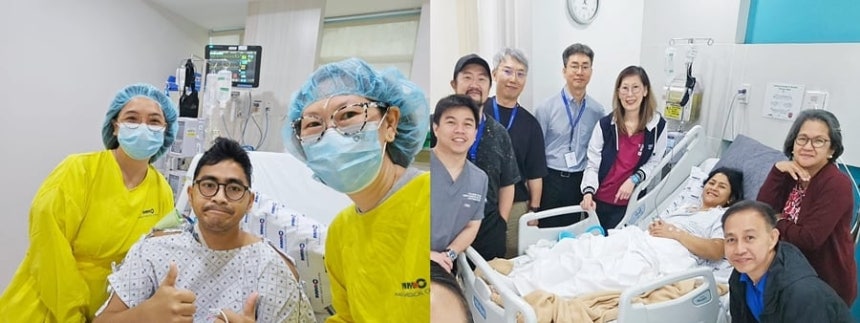Today's Korean 필리핀 청년 한국에서 생명 되찾아... The Asan Medical Center liver transplant team recently saved a 23-year-old Filipin
서울아산병원, 필리핀 청년에게 새 생명을
Asan Medical Center Gives New Life to Filipino Youth
서울아산병원 간이식팀이 최근 만성 담관 질환으로 목숨을 잃을 위기에 처한 23세 필리핀 청년을 살렸습니다.
The Asan Medical Center liver transplant team recently saved a 23-year-old Filipino youth who was on the verge of losing his life due to a chronic bile duct disease.
15일 서울아산병원에 따르면, 프란츠 아렌 바바오 레예즈씨는 4년 전부터 담관이 좁아져 염증이 생기는 희소 질환인 '원발성 경화성 담관염(PSC)'을 앓아왔습니다.
According to Asan Medical Center on the 15th, Mr. Franz Aren Baba-o Reyes has been suffering for four years from 'Primary Sclerosing Cholangitis (PSC),' a rare disease where the bile ducts narrow and become inflamed.
최근엔 패혈증으로 중환자실에 입원도 했습니다. 담관의 염증으로 간이 제 기능을 하지 못했기 때문으로 간 이식이 유일한 치료책이었습니다.
He was recently hospitalized in the intensive care unit for sepsis. Because his liver could not function properly due to the inflammation of the bile ducts, a liver transplant was the only treatment.
그의 어머니(50)가 간 일부를 기증하기로 했지만, 그 역시 과거 총상으로 몸이 허약한 상황이어서 수술 난도가 매우 높았습니다.
His mother (50) agreed to donate a part of her liver, but the surgery was highly difficult because she was also in a weakened state from a past gunshot wound.
결국 이들이 입원한 필리핀의 마카티병원은 간 이식 수술 경험이 세계에서 가장 많은 서울아산병원에 도움을 요청했습니다.
Ultimately, Makati Medical Center in the Philippines, where they were hospitalized, requested help from Asan Medical Center, which has the most liver transplant surgery experience in the world.
서울아산병원 간이식팀은 이를 받아들여 지난달 18일 필리핀에서 11시간에 걸친 대수술 끝에 간 이식을 무사히 마쳤습니다.
The Asan Medical Center liver transplant team accepted the request and, on the 18th of last month, successfully completed the liver transplant after an 11-hour major surgery in the Philippines.
어머니는 수술 후 5일 만에 퇴원했고, 레예즈씨도 이번 주 퇴원합니다.
The mother was discharged five days after the surgery, and Mr. Reyes will also be discharged this week.
“간 이식 분야 세계 최고 병원에서 수술을 해준다는 말을 듣고 처음으로 희망을 가졌습니다. 한국에 진심으로 감사드립니다.”
“When I heard that the world's best hospital in the field of liver transplantation would perform the surgery, I felt hope for the first time. I am truly grateful to Korea.”
수술을 집도한 김기훈 교수는 “환자를 살린다는 사명감으로 수술을 했다”고 말했습니다.
Professor Kim Ki-hoon, who led the surgery, said, “I performed the surgery with a sense of mission to save the patient.”
핵심 한국어 표현Key Korean Expressions
주요 어휘 (Key Vocabulary)
간이식 (gan-isik): Liver Transplant
설명 (Explanation): '간(肝)'은 'liver'를 의미하고, '이식(移植)'은 'transplant'를 의미합니다. 두 단어가 합쳐져 'liver transplant'라는 의학 용어가 됩니다.
'간(gan)' means liver, and '이식(isik)' means transplant. Combined, they form the medical term for 'liver transplant.'
예문 (Example): 간 이식이 유일한 치료책이었습니다.
A liver transplant was the only treatment.
목숨을 잃다 (moksum-eul ilta): To lose one's life
설명 (Explanation): '목숨'은 'life'를, '잃다'는 'to lose'를 의미하는 관용적 표현입니다. '죽다(to die)'보다 더 문어적인 느낌을 줍니다.
This is an idiomatic expression where '목숨 (moksum)' means life and '잃다 (ilta)' means to lose. It has a more literary feel than '죽다 (jukda, to die)'.
예문 (Example): 그는 전쟁에서 목숨을 잃었습니다.
He lost his life in the war.
사명감 (samyeong-gam): Sense of mission/duty
설명 (Explanation): '사명(使命)'은 'mission' 또는 'calling'을, '감(感)'은 'feeling' 또는 'sense'를 의미합니다. 자신에게 주어진 중요한 임무에 대한 책임감을 나타냅니다.
'사명 (samyeong)' means mission or calling, and '감 (gam)' means feeling or sense. It refers to the sense of responsibility for an important task given to oneself.
예문 (Example): 의사는 환자를 살린다는 사명감을 가져야 합니다.
A doctor must have a sense of mission to save patients.
핵심 문법 (Core Grammar)
V + -아/어/여오다: have been V-ing
설명 (Explanation): 이 문법은 과거의 어느 시점부터 현재까지 어떤 행동이나 상태가 계속 이어져 왔음을 나타냅니다. 동사 어간의 마지막 모음에 따라 형태가 바뀝니다.
This grammar pattern indicates that an action or state has continued from a certain point in the past up to the present. The form changes depending on the last vowel of the verb stem.
예문 (Example): 그는 4년 동안 희소병을 앓아왔습니다.
He has been suffering from a rare disease for four years.
Noun + (으)로 인해: due to / because of (Noun)
설명 (Explanation): 어떤 일의 원인이나 이유를 나타낼 때 명사 뒤에 붙여 사용합니다. 주로 부정적인 결과의 원인을 설명할 때 많이 쓰이며, 격식적인 상황이나 글에서 자주 보입니다. 명사가 자음으로 끝나면 '으로 인해', 모음으로 끝나면 '로 인해'를 씁니다.
This is attached to a noun to indicate the cause or reason for something. It is often used to explain the cause of a negative result and is frequently seen in formal situations or writing. Use '으로 인해' after nouns ending in a consonant and '로 인해' after nouns ending in a vowel.
예문 (Example): 폭설로 인해 비행기가 결항되었습니다.
The flight was canceled due to the heavy snow.
V + -ㄴ/는다는 말을 듣다: to hear that...
설명 (Explanation): 다른 사람에게서 들은 내용을 전달할 때 사용하는 간접 인용 표현입니다. 동사의 시제와 형태에 따라 '-ㄴ다(과거)', '-는다(현재)', '-ㄹ 거라(미래)' 등으로 변형됩니다.
This is a reported speech pattern used to convey something you heard from someone else. It changes to '-ㄴ다고', '-는다고', or '-ㄹ 거라고' depending on the verb's tense and form.
예문 (Example): 세계 최고 병원에서 수술을 해준다는 말을 듣고 희망을 가졌습니다.
I felt hope after hearing that the world's best hospital would perform the surgery.





